With the development of Cloud services and networking, 40G/100G whitebox switch become very popular in the market. These switches will provide Web scale organizations and service providers more control and flexibility in their data center networks. So what is whitebox switch? Whitebox switches refers to the ability to use ‘generic,’ off-the-shelf switching (or whitebox switching) and routing hardware, in the forwarding plane of a software-defined network (SDN). Moreover, whitebox switches rely on an operating system (OS), which may come already installed or can be purchased from a software vendor and loaded separately, and then integrate with the deploying organization’s Layer 2/Layer 3 topology and support a set of basic networking features. On the whole, OS is an integral part of whitebox switches, and the rise of SDN has brought whitebox switches into the public eye. Next, let’s take a closer look at whitebox switches.

Whitebox switches are useless without software, because every switch needs an operating system. The OS needs to seamlessly integrate with existing L2/L3 topology and support a basic set of features. A common operating system for whitebox switches is Linux-based, because many open and free Linux tools are available, which can help administrators customize the switches to their needs. Typically, a whitebox switch may come pre-loaded with minimal software or it may be sold as a bare metal device. The advantage of the whitebox switches is that switches can be customized to meet an organization’s specific business and networking needs.

However, how to put the OS on the whitebox switches? Some vendors sell a complete solution with the OS that is already installed on the whitebox, while others set up distributors to provide the bare metal devices that the OS is directly brought from the software vendor. Both of these two approaches are feasible, depending on the scale of the deployment and the desire for the network.
Beyond the operating system, whitebox switches are more valuable if they interact with SDN controllers. And the widespread implementation of SDN has boosted the use of whitebox switches. SDN is an approach to design, build and manage networks, which can separate the network’s control and forwarding planes. In result, the network control will become directly programmable and the underlying infrastructure will be abstracted for applications and network services. The goal of SDN is to enable cloud and network engineers and administrators to respond quickly to changing business requirements via a centralized control console. At the same time, the switches in SDN environment rely on software-based network function virtualization (NFV), which offers great convenience for the users of whitebox switches. Because whitebox switch allows its customers to choose the best suitable operating system for themselves. And in the future, most whitebox switches will function in an SDN environment in which the SDN controller is making forwarding and control-plane decisions from a centralized point for all switches in the network.

In general, the data center Ethernet switch market has seen tremendous growth and investment over the past years. The Layer 2-3 Ethernet switch market is expected to exceed $25 billion in 2019, according to Dell’Oro Group. What’s more, some high-end users are tired of vendor lock-in switches, and they might be ready to try a whitebox switch to get what they want. Whitebox switches can customize the system to limit unneeded processes and concentrate the processing power of the switch on the important features, so it leads to a customized switch platform that provides perfect performance for a narrow range of uses. Customers with highly unique support needs will also benefit from whitebox switches. Through the separation of software and hardware, customers can obtain different support levels for hardware and software.
FS.COM 40G/100G whitebox switches are based on IPinfusion’s ZebOS with integration of Layer 2 to Layer 4 packet processing engine, traffic management and fabric interface. The aim is to achieve flexibility, scalability, efficiency and cost effectiveness in data center networks. Furthermore, the operating systems of these switches are developed on the basis of Linux. Last but not least, all the 40G/100G whitebox switches in FS.COM support SDN function which can make networks more affordable and easier to manage.

All in all, the whitebox switches support current and future data center requirements, which is ideally suited for data center environments in either Leaf or Spine deployments. They provide superior low latency and power efficiency in a clean PHYless design, while offering high reliability features such as redundant and hot swappable power supplies and fans in forward and reverse airflow configurations. And they provide QSFP+ ports, which enable flexible choices of port speed providing unparalleled flexibility and the ability to seamlessly transition data centers to the next generation of Ethernet performance.
Whitebox switches can be deployed either in the data center or in the access network, which can reduce capital expenditures and leverage open SDN tools to improve time to deployment and automation. If you want to deploy whitebox switches with lower cost and great flexibility, welcome to contact us via www.fs.com.
